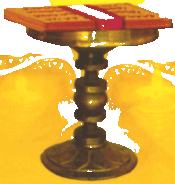Manuscripts: The Preparation Process

When the Ahoms invaded Assam ...The use of paper was unknown, and they employed instead strips of bark of the Sanchi tree known in Bengal as Agar (Aquilaria Agallocha), the Aloes wood of the Bible....
The manner of preparing the bark for use as a writing material is as follows:
A tree is selected of about 15 or 16 years growth and 30 to 35 inches in girth, measured about 4 feet from the ground. From this the bark is removed in strips, from 6 to 18 feet long, and from 3 to 27 inches in breadth. These strips are rolled up separately with the inner or green part inside, and are dried in the sun for several days. They are then rubbed by hand on a board, or some other hard substance, so as to facilitate the removal of the outer or scaly portion of the bark. After this, they are exposed to the dew for one night.
 Next morning the outer layer of the bark (nikari) is carefully removed, and the bark proper is cut into pieces of a convenient size, 9 to 27 inches long and 3 to 18 inches broad. These are put in cold water for about an hour, and the alkali is extracted, after which the surface is scraped smooth with a knife. They are then dried in the sun for half an hour, and when perfectly dry, are rubbed with a piece of burnt brick.
Next morning the outer layer of the bark (nikari) is carefully removed, and the bark proper is cut into pieces of a convenient size, 9 to 27 inches long and 3 to 18 inches broad. These are put in cold water for about an hour, and the alkali is extracted, after which the surface is scraped smooth with a knife. They are then dried in the sun for half an hour, and when perfectly dry, are rubbed with a piece of burnt brick.
 A paste prepared from from matimah (Phaseolus radiatus) is next rubbed in, and the bark is dyed yellow by means of yellow arsenic. This is followed again by sun-drying, after which the strips are rubbed as smooth as marble.
A paste prepared from from matimah (Phaseolus radiatus) is next rubbed in, and the bark is dyed yellow by means of yellow arsenic. This is followed again by sun-drying, after which the strips are rubbed as smooth as marble.
The process is now complete, and the strips are ready for use.
The labour of preparing the bark and of inscribing the writing is considerable, and, apart from this, much greater value is attached to an old manuscript, or puthi, than to a new copy of it. These puthis are very carefully preserved, wrapped up in pieces of cloth, and are handed down as heirlooms from father to son.
Tulapat is essentially a paper made from wood pulp. Three kinds of trees were normally selected for the purpose. White tulapat was made from the 'maihai' tree, the dark brown variety from the 'Yamon' and the red variety from a tree the name of which has not been found. The 'Yamon' tree has been identified with the 'hsa' of the Shan people and 'nuni' or paper mulberry in Assamese (Bronsanettia Papyrifera).
The barks of the above mentioned trees were cut up in convenient sizes and beaten thoroughly. This broke the fibres and separated and loosened them. Then these were boiled till they melted and formed into a fine pulp and became cleared of all impurities. The pulp was next poured over water kept in rectangular ditches of required sizes and it floated on the water's surface. It was then evenly spread all over with a scraper to the shape of the watery surface. Then it was left to cool. When cool, the film of pulp lying on the surface of the water gave a sheet of strong and tough paper.
Usually, a tulapat folio was made by stitching two single sheets together or by folding a longer sheet in two and then stitching the same. This was done to give strength to the folios.